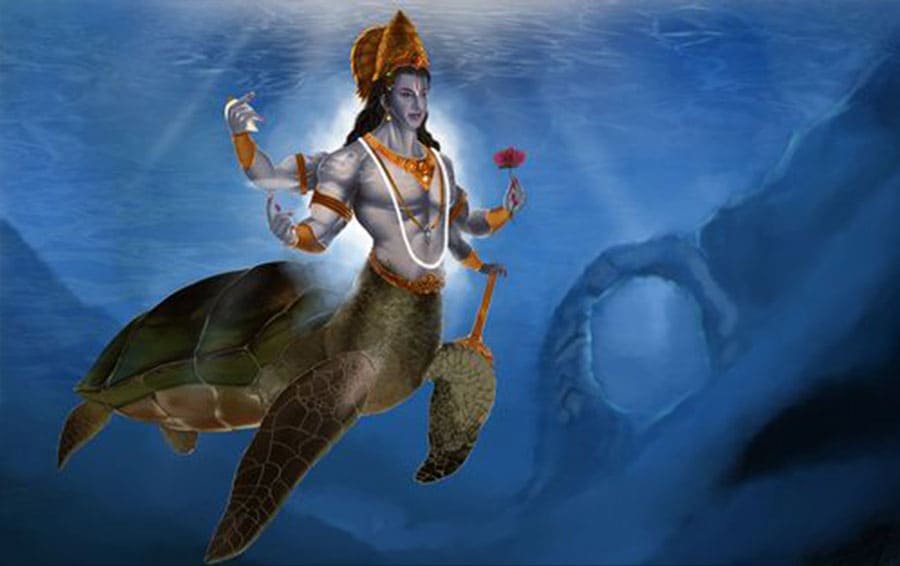Kurma Purana with meaning
Kurma Purana

The Kūrma Purāṇa: History and Context
The Kūrma Purāṇa is one of the eighteen Mahāpurāṇas of Hindu tradition. It takes its name from Kūrma, the tortoise incarnation of Vishnu, who supported Mount Mandara during the famous churning of the ocean (samudra manthana). While the avatāra itself is central, the Purāṇa is not limited to that story. Instead, it offers a broad compilation of theology, mythology, sacred geography, and religious practice.
Date and Composition
The Kūrma Purāṇa, like other Purāṇas, is a layered text compiled over centuries. Scholars generally date its core between the 7th and 9th centuries CE, with later revisions continuing into the medieval period (possibly up to the 13th century CE).
The text survives in multiple recensions and is considered relatively short compared to other Mahāpurāṇas. The extant version has about 17,000 verses (in 95 chapters), though some manuscripts suggest a slightly smaller corpus. The style of composition indicates it was used as a religious handbook rather than an exhaustive encyclopedic Purāṇa.
Structure and Content
The Kūrma Purāṇa is framed as a dialogue between Vishnu in his Kūrma form and various sages. It is usually divided into two parts:
- Pūrva-vibhāga (First Section)
- Cosmology and cycles of creation and dissolution.
- Narratives of gods, sages, and kings.
- Accounts of Vishnu’s incarnations, with special emphasis on the Kūrma avatāra.
- Mythological episodes connected with the samudra manthana.
- Uttara-vibhāga (Second Section)
- Philosophical and theological discourses, especially on Vedānta.
- Glorification of both Vishnu and Shiva, emphasizing a non-sectarian outlook.
- Detailed instructions on pilgrimage (tīrtha-māhātmya), especially sites in South India.
- Guidance on rituals, vows (vratas), and devotional practices.
Religious Orientation
Although named after Vishnu’s Kūrma avatāra, the text is not exclusively Vaishnava. Many sections praise Shiva, Devi, and other deities, showing an inclusive and syncretic character. This reflects the religious pluralism of medieval Hinduism, where texts sought to harmonize competing sectarian traditions.
Its emphasis on Vedānta philosophy is noteworthy. Passages in the Uttara-vibhāga align closely with Advaita (non-dualist) ideas, suggesting that it was influenced by or contributed to early Vedāntic currents. This gives the Purāṇa a philosophical depth not always found in other texts.
Cultural and Historical Significance
The Kūrma Purāṇa is significant for its tīrtha-māhātmya (pilgrimage sections), which describe sacred places and their spiritual benefits. These accounts helped establish religious geographies and encouraged pilgrimage networks. Temples in Tamil Nadu, Andhra Pradesh, and Odisha are praised, making the text an important source for medieval South Indian religious culture.
It also provides guidance on ritual observances, temple worship, and yoga, blending practical religion with philosophical insight. The syncretic approach—balancing Vishnu, Shiva, and Devi—made it accessible to multiple communities.
Historical Influence
While less famous than the Bhāgavata Purāṇa or Viṣṇu Purāṇa, the Kūrma Purāṇa played a role in shaping devotional practices and sacred geography in medieval India. Its theological inclusivity resonated with Advaita Vedānta traditions, and its pilgrimage guides supported temple-based Hinduism.
Above all, the Kūrma Purāṇa illustrates the Purāṇic function as a living religious encyclopedia, combining myth, philosophy, and practice into a text that could serve both scholars and devotees.




















































